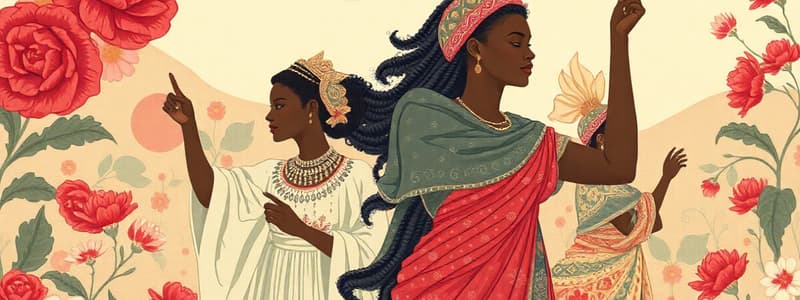Podcast
Questions and Answers
What event in 1973 significantly contributed to political organizational renewal?
What event in 1973 significantly contributed to political organizational renewal?
- Community organizing against colonialism
- Women's education initiatives
- Formation of new political parties
- Students' mobilization against apartheid education (correct)
Which of the following organizations was formed to address women's issues within the political sphere?
Which of the following organizations was formed to address women's issues within the political sphere?
- Federation of Workers' Unions
- Federation of Transvaal Women (FEDTRAW) (correct)
- South African Youth Congress
- National Democratic Party
Why is the role of women as political activists often underrepresented according to feminist writers?
Why is the role of women as political activists often underrepresented according to feminist writers?
- Women were primarily focused on domestic issues
- Women's organizations had little influence
- Political theory is dominated by male biases (correct)
- Women did not participate in politics
What prompted women's mobilization into trade unions during the apartheid era?
What prompted women's mobilization into trade unions during the apartheid era?
What was one major failure in the initial frame of mobilization for women within the apartheid context?
What was one major failure in the initial frame of mobilization for women within the apartheid context?
What challenge did women active in trade unions make against COSATU's draft logo?
What challenge did women active in trade unions make against COSATU's draft logo?
Which of the following best describes the nature of women's activism in trade unions during the period discussed?
Which of the following best describes the nature of women's activism in trade unions during the period discussed?
What aspect of women's studies has been criticized regarding their analysis of women in trade unions?
What aspect of women's studies has been criticized regarding their analysis of women in trade unions?
What was one of the main challenges posed by women in the union leadership structures?
What was one of the main challenges posed by women in the union leadership structures?
What specific workplace issues did women challenge through their activism?
What specific workplace issues did women challenge through their activism?
Who were the participants of the study focused on women’s mobilization in South Africa?
Who were the participants of the study focused on women’s mobilization in South Africa?
What often drives democratic transitions, according to the analysis provided?
What often drives democratic transitions, according to the analysis provided?
What is a likely outcome of soft-liners dominating a political environment?
What is a likely outcome of soft-liners dominating a political environment?
What critical role do social movement organizations play during transitions?
What critical role do social movement organizations play during transitions?
The study encompassed women’s mobilization into trade union activities during which years?
The study encompassed women’s mobilization into trade union activities during which years?
Which aspect of society did activists aim to challenge through their efforts?
Which aspect of society did activists aim to challenge through their efforts?
What was the primary focus of the Malibongwe women's conference in January 1990?
What was the primary focus of the Malibongwe women's conference in January 1990?
What significant event occurred in February 1990 concerning political organisations in South Africa?
What significant event occurred in February 1990 concerning political organisations in South Africa?
Which challenge did women face during the transition to a democratic South Africa?
Which challenge did women face during the transition to a democratic South Africa?
What was a key reason why COSATU women's structures could not easily merge into the ANCWL?
What was a key reason why COSATU women's structures could not easily merge into the ANCWL?
Which of the following statements is true regarding the ANCWL in August 1990?
Which of the following statements is true regarding the ANCWL in August 1990?
What was a notable characteristic of women’s organisations during the apartheid era?
What was a notable characteristic of women’s organisations during the apartheid era?
What was one of the implications of the ANCWL merging with previous women’s organisations in 1991?
What was one of the implications of the ANCWL merging with previous women’s organisations in 1991?
What role did COSATU women’s structures primarily focus on?
What role did COSATU women’s structures primarily focus on?
What role did women in Chile, El Salvador, and Argentina predominantly take on while protesting human rights abuses?
What role did women in Chile, El Salvador, and Argentina predominantly take on while protesting human rights abuses?
In Argentina, what significant effect did women's protests have on authoritarian governments?
In Argentina, what significant effect did women's protests have on authoritarian governments?
What social issues did organizations formed by women in Chile address during the economic crisis of the 1980s?
What social issues did organizations formed by women in Chile address during the economic crisis of the 1980s?
What major protest occurred in South Africa in 1956, involving a significant number of women?
What major protest occurred in South Africa in 1956, involving a significant number of women?
How did the socioeconomic hardships under authoritarian regimes influence women's organization?
How did the socioeconomic hardships under authoritarian regimes influence women's organization?
What was a result of the political suppression faced by African communities during the 1960s?
What was a result of the political suppression faced by African communities during the 1960s?
What key theme did women's movements in Chile, El Salvador, and Argentina expand towards?
What key theme did women's movements in Chile, El Salvador, and Argentina expand towards?
What was one significant outcome of the 1956 women's march in South Africa?
What was one significant outcome of the 1956 women's march in South Africa?
What issue does Buhlungu address in his writings?
What issue does Buhlungu address in his writings?
What is the focus of Fonow's work titled 'Women of Steel'?
What is the focus of Fonow's work titled 'Women of Steel'?
What topic does Gasa explore in her edited work on women in South African history?
What topic does Gasa explore in her edited work on women in South African history?
Kenny's work on retail sector workers highlights what specific issue?
Kenny's work on retail sector workers highlights what specific issue?
What common theme is present in the writings of O'Donnell and Schmitter regarding democracy?
What common theme is present in the writings of O'Donnell and Schmitter regarding democracy?
Which aspect does Hassim focus on in 'Women’s Organizations and Democracy in South Africa'?
Which aspect does Hassim focus on in 'Women’s Organizations and Democracy in South Africa'?
Phillips' work, 'Engendering Democracy,' primarily addresses what concept?
Phillips' work, 'Engendering Democracy,' primarily addresses what concept?
What is the primary focus of Mosoetsa's research on women in the footwear industry?
What is the primary focus of Mosoetsa's research on women in the footwear industry?
Flashcards are hidden until you start studying
Study Notes
Women's Movement in South Africa
- Women played a critical role in opposing human rights abuses, socio-economic issues, and gender discrimination in authoritarian regimes.
- Mothers organized in Chile, El Salvador, and Argentina to protest the disappearance of their children and demand their safe return.
- Women challenged the authority of the state by using their roles as mothers.
- South African women were instrumental in anti-colonial and anti-apartheid struggles.
- A major protest against the extension of pass laws to women was held in 1956, with 20,000 women participating.
- The pass protest was significant in mobilizing women for the struggle against apartheid.
- Government repression following the Pass Laws protests led to the suppression of political organizations and a period of limited overt political mobilization.
- Political activism re-emerged in the 1970s with workers' and student movements against apartheid.
- The 1980s saw the rise of community-based organizations, engaging women in organizational politics.
- Women's organizations like FEDTRAW, UWO, and NOW emerged during this period.
- The role of women as activists is underrepresented in analyses of democratic transitions.
- Feminist writers highlight sexist biases in the study of political actors and participation.
- The study focuses on the significant impact of trade union women in South Africa's democratic transition from 1973 to 2003.
- Women's mobilization into trade unions was initially focused on combating racism and apartheid oppression within the workplace.
- Trade union activism enabled women to engage in multi-layered struggles for gender equality, addressing:
- Recognition of their contributions in workplace struggles
- Challenging sexism and discrimination in workplace policies, including wage inequalities, maternity leave, and sexual harassment
- Fighting political domination and sexism within apartheid policies
- Women's experiences during these struggles informed their involvement and demands during the democratic transition.
- The study is based on life history interviews with 28 African women who were active members of COSATU in Gauteng.
Trade Unions and Democratic Transition
- The role of elites in democratic transitions is often emphasized, with emphasis placed on divisions between hardliners and soft-liners.
- Social movements and grassroots organizations are crucial in overthrowing autocratic regimes.
The Struggle For Control of the Women's Movement
- The Malibongwe women's conference in 1990 sought to unite women in fighting gender inequality.
- The need for a national women’s movement to articulate collective interests and demands during the transition was highlighted.
- The ANCWL sought to gain control of the women’s movement in South Africa.
- The ANCWL absorbed most women’s organizations affiliated with the UDF in 1991.
- The organization of women within COSATU presented a challenge to the centralisation of power within the ANCWL, as it represented a significant portion of the working-class.
- COSATU women's structures, organized nationally, presented a different base for women's activism.
- COSATU's women structures held annual conferences, offering a distinct avenue for women's political participation.
Studying That Suits You
Use AI to generate personalized quizzes and flashcards to suit your learning preferences.




